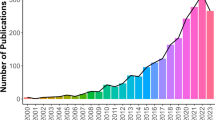Abstract
The levels of nuclear mRNAs for three light-inducible proteins (light-harvesting chlorophyll a/b protein, small subunit of ribulose-1,5-bisphosphate carboxylase and early light-induced protein) have been analyzed under light-dark and constant light conditions. The levels of all three mRNAs have been found to vary considerably during the day, both under ligh-dark and under constant light conditions, demonstrating the existence of diurnal and circadian rhythmicity in the expressionoof these nuclear-coded plant proteins. The levels of two of these mRNAs have been found to be enhanced 2 h before the beginning of illumination when active phytochrome levels are still low.
Similar content being viewed by others
Abbreviations
- ELIP:
-
early light-inducible protein
- LHCP:
-
light-harvesting chlorophyll alb protein; poly(A)RNA=polyadenylated RNA
- (ss)RuBPCase:
-
(small subunit) ribulose-1,5-bisphosphate carboxylase
References
Apel, K. (1979) Phytochrome-induced appearance of mRNA activities for the apoprotein of the light harvesting chlorophyll a/b protein of barley (Hordeum vulgare). Eur. J. Biochem. 97, 183–188
Apel, K. (1981) The protochlorophyllide holochrome of barley (Hordeum vulgare). Phytochrome induced decrease of translatable mRNA coding for the NADPH: protochlorophyllide oxidoreductase. Eur. J. Biochem. 120, 89–93
Apel, K., Kloppstech, K. (1978) The plastic membranes of barley (Hordeum vulgare). Light-induced appearance of the mRNA for the apoprotein of the light-harvesting chlorophyll a/b protein. Eur. J. Biochem. 85, 581–588
Bonner, W.M., Laskey, R.A. (1974) A film detection method for tritium-labeled proteins and nucleic acids in polyacrylamide gels. Eur. J. Biochem. 46, 83–88
de Vries S.C., Harmsen, M.C., Kniper, M.T.R., Dons, H.J.M., Wessels, J.H.G. (1983) Molecular cloning of pea mRNAs encoding a shoot specific polypeptide and light-induced polypeptides. Plant Mol. Biol. 2, 295–303
Ehret, C.F., Trucco, E. (1967) Molecular models for the cireadian clock. I. The chronon concept. J. Theor. Biol. 15, 240–262
Katz, L., Kingsbury, D.T., Helinski, D.R. (1973) Stimulation by cyclic adenosine monophosphate of plasmid deoxyribonucleic acids in polyacrylamide gels. J. Bacteriol. 114, 577–591
Kloppstech, K., Meyer, G., Bartsch, K., Hundrieser, J., Link, G. (1984) Control of chloroplast gene expression during the early phase of chloroplast development. In: Compartments in algal cells and their interaction, pp. 36–46, Wiessner, W., Robinson, D.G., Starr, R.C., eds. Springer, Berlin Heidelberg New York
Lodish, H.F. (1976) Translational control of protein synthesis. Annu. Rev. Biochem. 45, 39–79
Meyer, G., Kloppstech, K. (1984) A rapidly light-induced chloroplast protein with a high turnover coded for by pea nuclear DNA. Eur. J. Biochem. 138, 201–207
Neville, O.M. (1971) Molecular weight determination of protein-dodecyl-sulfate complexes by gel electrophoresis in a discontinuous buffer system. J. Biol. Chem. 246, 6328–6334
Rigby, R.W., Dieckmann, M., Rhodes, C., Berg, P. (1977) Labelling deoxyribonucleic acid to high specific activity in vitro by nick-translation with DNA polymerase. J. Mol. Biol. 113, 237–251
Roberts, B.W., Patterson, B.M. (1970) Efficient translation of tobacco mosaic virus RNA and globin 9S RNA in a cell-free system from commercial wheat germ. Proc. Natl. Acad. Sci. USA 70, 2330–2334
Tobin, E.M., Suttie, J.L. (1980) Light effects on the synthesis of ribulose-1,5-bisphosphate carboxylase in Lemma gibba. Plant Physiol. 65, 641–647
Scharnhorst, C., Heinze, H., Meyer, G., Kolanus, W., Bartsch, K., Heinrichs, S., Gudschun, T., Möller, M., Herzfeld, F. (1984) Molecular cloning of a pea mRNA encoding an early light induced, nuclear coded chloroplast protein. Plant Mol. Biol., 4, 241–245
Schweiger, H.G., (1969) Cell biology of Acetabularia. Curr. Top. Microbiol. Immunol. 50, 1–36
Steinback, K.E., Pfister, K., Artzen, Ch.J. (1981) Trypsin-mediated removal of herbicide binding sites within the photosystem II complex. Z. Naturforsch. Teil C 36, 98–108
Author information
Authors and Affiliations
Rights and permissions
About this article
Cite this article
Kloppstech, K. Diurnal and circadian rhythmicity in the expression of light-induced plant nuclear messenger RNAs. Planta 165, 502–506 (1985). https://doi.org/10.1007/BF00398095
Received:
Accepted:
Issue Date:
DOI: https://doi.org/10.1007/BF00398095




